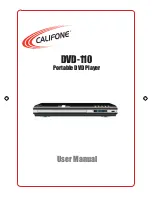
10.
TRACK SELECT/SEARCH-
c.
Rotation – selects tracks
d.
Pressing while rotating – selects
10
e.
Pressing once- Puts wheel in search
mode.
11.
PITCH- Actives and sets pitch slider range.
12.
KEY- Used for various key control.
13.
-,+ - Works as pitch bend and controls key
and pitch functions.
14.
PITCH SLIDER- Controls the overall speed
of the music.
15.
PITCH RANGE LED- Indicates current pitch
range of the pitch slider
16.
EFFECT BUTTON- Used to determine
desired effect.
17.
EFFECT HOLD- Used to set effects to an
alternate position
18.
LOOP IN- Used to set stutter and loop in
points.
19.
LOOP OUT- Used to set loop out points and
release the loop.
20.
RELOOP/STUTTER- Used for repeated play
(stutter) from the loop in point, repeating a
previously set, and hot start.
21.
RELAY- Used for setting Alternating play
start between attached units.
22.
& 23.
BEAT SYNC with MARCHING BAR
GRAPH- Tracks the beats and measure
position of music
24.
INTERLOCK- Links both players for beat
alignment.
25.
Slot Load CDRW Drive – designed to play
commercially available CD and properly
burned CDR and CDRW discs. Insert the
CDs you wish to play here.
26.
Disc Indicator – illuminates when disc is in
Drive.
27.
Eject Button - used to eject CDs from the
player. The CD will only eject when it is
not playing.
28.
Power Switch- Turn on and turn off the
machine with this button. The unit should
always be shut down with this button first
before any external power is removed.
Typically it is recommended that the CD
player is powered on before amplifiers and
off after amplifiers to avoid an audio spike
to be sent through your equipment.
29.
IEC Power Plug Connector - Plug your
supplied power cord in here.
30.
Control Cable Connector- Plug in the 8-pin
cable included in here to connect the
remote control and main CD unit together
31.
RCA Audio Connectors - Connect your CD
player to your mixer from this line level
output.
32.
Digital Output - The format is type 2, form
1, also known as S/PDIF (Sony/Phillips
Digital Interface Format). To active digital
output, hold down “PROG” followed by
“PITCH”. This allows digital audio
information to be sent. Some CDs also
have information encoded in the original
audio output such as CDG graphic CDs for
Karaoke.
33.
Remote Start Connector – Use this
connector to plug into your fader start
compatible mixer or remote switch. This
function is always active.
a.
To use this connector for fader start,
connect the supplied fader start cable to a
fader start compatible mixer. Every time
you move the crossfader on the mixer over
to the side that the unit is on, it will
automatically start playing. When you
move the fader away from that side, the
unit will stop. Moving the fader back to the
unit side will start play again.
b.
Foot switches can also be attached to this
jack for creative mixing techniques and can
be found in most music shops. Connector
plugs are often ¼” and an adapter to 1/8”
will be needed for connection. There are
also two types of footswitches that will
work with this connector. The first is a
typical, on/off pushbutton switch and are
generally used for switching channels on
guitar amps. The second switch is a
momentary footswitch and is usually used
for keyboard sustain pedals.
34.
MIDI IN Connector – The port is for
receiving MIDI (Musical Instrument Digital
Interface) signals from other MIDI devices
such as CD players, Keyboards, or Drum
machines.
35.
MIDI OUT Connector – The port is for
sending MIDI signals to other MIDI devices.






























